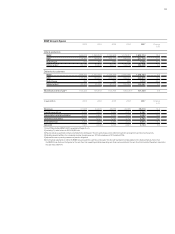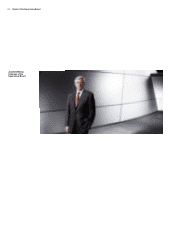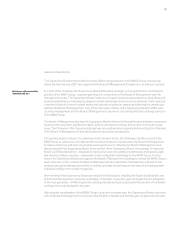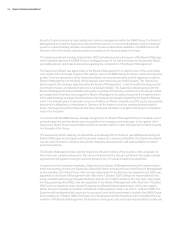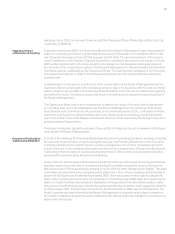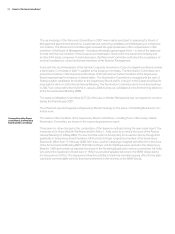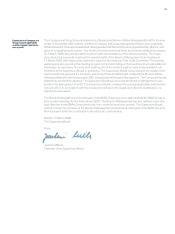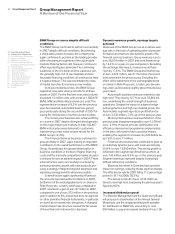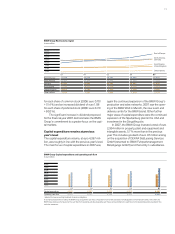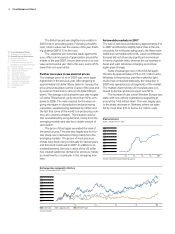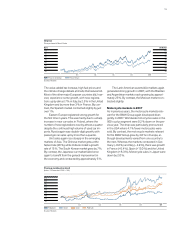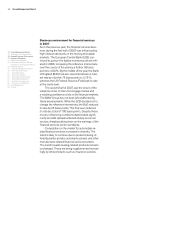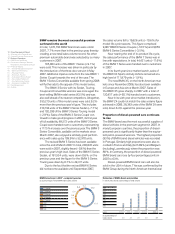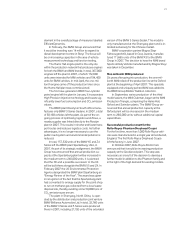BMW 2007 Annual Report Download - page 15
Download and view the complete annual report
Please find page 15 of the 2007 BMW annual report below. You can navigate through the pages in the report by either clicking on the pages listed below, or by using the keyword search tool below to find specific information within the annual report.13
Economic developments in 2007
The global economy again grew strongly in 2007,
albeit at a slightly slower pace than in the previous
year. In addition to rising interest rates and the con-
tinuing high level of raw material prices, the main
reason for this development was the weakening of
the US residential property market and the resulting
weaker economic growth in the USA. Although the
credit crisis became acute from the middle of the
year onwards, the effects it had on the economy in
2007 were relatively minor and mainly restricted
to
the USA. In other countries, primarily the financial
markets were affected. In a number of instances,
central banks were forced to take measures to en-
sure that sufficient liquid funds were available on
the markets.
After a slow start at the beginning of the year,
the US economy picked up pace again over the
course of 2007, despite the enormous pressure
coming from the residential property sector. Rising
interest rates in recent years resulted in a large vol-
ume of bad debt losses, primarily in the area of sub-
prime borrowers. As a consequence, investment on
new residential property fell to an all-time low, with
property prices dropping for the first time in more
than 15 years. Despite these developments, private
consumption nevertheless grew sharply due to the
employment market remaining strong up to autumn.
In the face of the weak residential property market,
the rise in investment volumes was far lower than
that of the previous year. On the back of a weaker US
dollar, exports provided some momentum for the first
time in years with the result that the USA’s current
account deficit decreased slightly. Overall, the USA’s
gross domestic product grew by 2.2 % in 2007.
The euro region also registered strong growth
in 2007, albeit at a somewhat slower rate than in the
previous year. Despite the positive changes evident
on the employment market, consumers were more
reluctant to spend than one year earlier, whereas in-
vestment activity continued to increase sharply. Ex-
ports grew despite the strong euro. The current bal-
ance of the region as a whole was slightly positive,
although the results in individual countries varied con-
siderably. Overall, the euro region’s economy grew
by 2.7 % in 2007.
Economic growth in Germany weakened slightly
in 2007, reflecting the trend seen in the euro region
as a whole. Investment and exports again contributed
strongly to economic growth. By contrast, private
consumption failed to match the mildly positive trends
seen in previous years and stagnated in 2007. One
of the main negative factors was the value-added tax
increase that took effect in Germany at the beginning
of the year. Although the employment market im-
proved, and large numbers of new jobs were creat-
ed, this did not motivate consumers to spend more.
On top of this, from the summer onwards, the impe-
tus generated by the construction industry tailed off
sharply. Despite these adverse factors, the growth
rate of 2.5 % was only marginally below the previous
year’s level.
The economies of the new EU member coun-
tries also continued to grow robustly in 2007. Private
consumption and investment rose sharply in many
countries, but in spite of the increase in exports,
the current accounts of these countries remained,
for the most part, negative and in some cases quite
considerably so.
The Japanese economy remained on a stable
growth course in 2007 with momentum coming
from both domestic demand and exports. However,
the persisting worry of deflation remained in 2007,
resulting in price stagnation during the year. The
general price level increased only marginally, almost
entirely due to higher energy prices. The Japanese
Central Bank was therefore only able to raise interest
rates very slightly above zero. Overall, Japan’s gross
domestic product grew by approximately 2.1 % in
2007.
Alongside the emerging economies of Eastern
Europe, the fastest growth rates were again recorded
in 2007 by the markets in Latin America and East
Asia. Once again, China was one of the fastest grow-
ing markets. The investment boom there continued
in 2007 with the export surplus reaching a new record
figure. The monetary policy measures taken, includ-
ing higher interest rates, failed to hold down
eco-
nomic growth and a growth rate in excess of 11 % was
registered for the year. In India, too, economic growth
remained extremely strong at over 8 %. As in previous
years, however, the Indian current account remained
negative.
US dollar continues to lose value over the
course of the year
The US dollar continued to lose value sharply over
the course of 2007. After standing at US dollar 1.32
to the euro in January, it closed the year almost
10 % weaker at US dollar 1.46 to the euro. A rate of
almost US dollar 1.50 to the euro was recorded at
some stage during the period.
General Economic Environment


